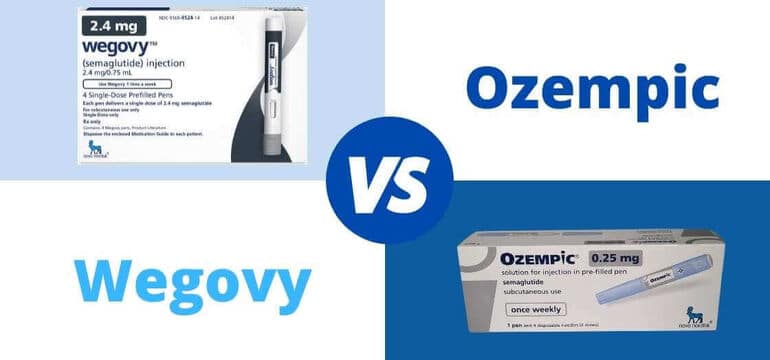Wegovy vs Ozempic: A Comprehensive Comparison
Wegovy and Ozempic belong to the class of medications known as glucagon-like peptide-1 (GLP-1) receptor agonists. Both drugs are developed by Novo Nordisk and contain the same active ingredient, semaglutide.
Semaglutide was first introduced as Ozempic in 2017 for diabetes management. In 2021, Novo Nordisk launched Wegovy with a higher dose of semaglutide, specifically targeting overweight and obesity.
Both Wegovy and Ozempic have received FDA approval for long-term weight management when used in conjunction with dietary and lifestyle changes.
These medications are suitable for individuals with a body mass index (BMI) of 30 or above, and are also beneficial for those with a BMI of 27 or higher who have additional health concerns such as type 2 diabetes or hypertension.
Understanding Wegovy
Wegovy is the first drug to gain FDA approval for chronic weight management since 2014.
The higher dosage of semaglutide in Wegovy allows for better penetration of the blood-brain barrier, which can enhance weight loss outcomes. During the initial treatment phase, healthcare providers typically start patients on a low dose, gradually increasing it over 16–20 weeks.
The initial dosage for Wegovy is 0.25 mg per week, with the potential to increase up to 2.4 mg each week. Gradually raising the dose can help minimize side effects.
Common side effects of Wegovy include:
- Nausea and vomiting
- Diarrhea, constipation, and abdominal pain
- Headache and dizziness
- Fatigue
- Dyspepsia, abdominal distension, and burping
- Hypoglycemia in patients with type 2 diabetes
- Flatulence, gastroenteritis, and acid reflux
Severe side effects may include:
- Thyroid C-cell tumors
- Acute pancreatitis
- Acute gallbladder disease
- Acute kidney injury
- Hypersensitivity
- Diabetic retinopathy complications in patients with type 2 diabetes
- Increased heart rate
- Suicidal behavior and thoughts
FDA studies have underscored Wegovy’s effectiveness as a weight management therapy.
In one clinical trial, participants on Wegovy lost an average of 12.4% of their initial body weight, with an average BMI of 38. Another study comparing Wegovy to a placebo found that those on Wegovy experienced a 6.2% reduction in their starting weight.
The cost of Wegovy can exceed $1,500 per month without insurance. Those with coverage may pay as little as $25 per month. Various factors, including insurance coverage and local pharmacy pricing, can influence the total cost.
Understanding Ozempic
Ozempic is used alongside diet and exercise to help individuals with type 2 diabetes manage their blood sugar levels. Additionally, Ozempic reduces the risk of stroke, heart attack, or death in adults with existing type 2 diabetes and cardiovascular disease.
Although Ozempic and Wegovy contain the same active ingredient, Ozempic is available at a lower dosage.
Similar to Wegovy, doctors typically start patients on a low dose of Ozempic, 0.25 mg per week, with the possibility of increasing by 0.25 mg every four weeks as recommended.
Common side effects of Ozempic include:
- Nausea
- Diarrhea
- Stomach pain
- Constipation
More severe side effects can include:
- Thyroid tumors and medullary thyroid carcinoma
- Kidney problems, including kidney failure
- Pancreatitis
- Severe allergic reactions
- Vision changes
- Severe hypoglycemia
Ozempic has demonstrated effectiveness in promoting weight loss when used alongside diet and exercise. It is also a proven treatment for managing type 2 diabetes.
The cost of Ozempic can vary widely based on insurance coverage. Without insurance, it may cost upwards of $800 per month, while those with coverage may pay as little as $25 per month.
